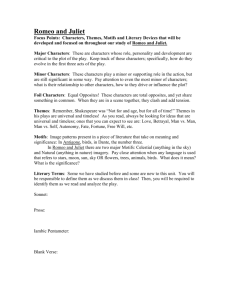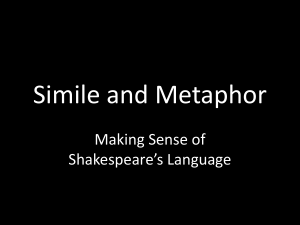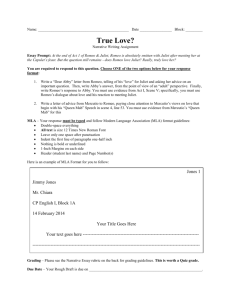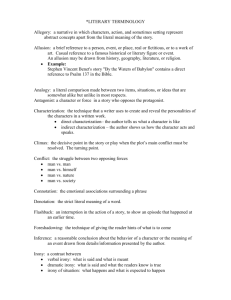Writing Prompt 3 Gr 9 2010-11 Romeo and Juliet Literary Analysis
advertisement
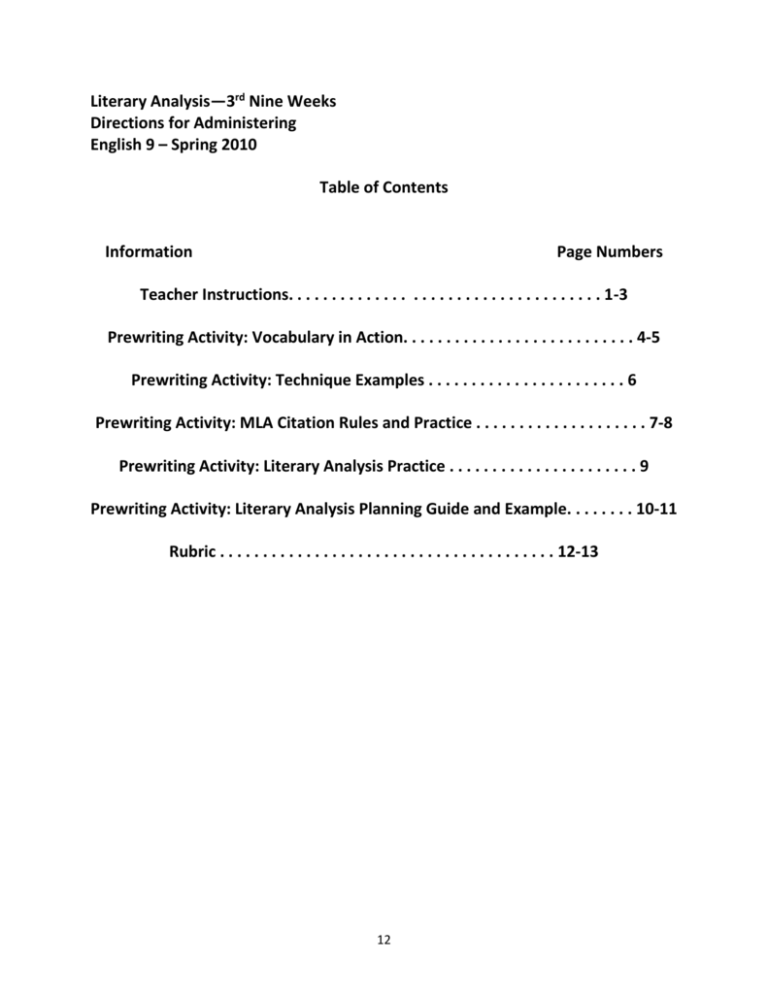
Literary Analysis—3rd Nine Weeks Directions for Administering English 9 – Spring 2010 Table of Contents Information Page Numbers Teacher Instructions. . . . . . . . . . . . . . . . . . . . . . . . . . . . . . . . . . . . 1-3 Prewriting Activity: Vocabulary in Action. . . . . . . . . . . . . . . . . . . . . . . . . . . 4-5 Prewriting Activity: Technique Examples . . . . . . . . . . . . . . . . . . . . . . . 6 Prewriting Activity: MLA Citation Rules and Practice . . . . . . . . . . . . . . . . . . . . 7-8 Prewriting Activity: Literary Analysis Practice . . . . . . . . . . . . . . . . . . . . . . 9 Prewriting Activity: Literary Analysis Planning Guide and Example. . . . . . . . 10-11 Rubric . . . . . . . . . . . . . . . . . . . . . . . . . . . . . . . . . . . . . . . 12-13 12 Greetings! This writing prompt reflects the joint work and wisdom of the Language Arts Task Force and the continuing efforts of the members of the English 9 CCT. Its purpose is to assess students’ writing to better inform our instruction. Please read these directions carefully; we want to make sure all students have the same test conditions. The testing administration window is ____________. If you have questions about any aspect of this assessment, please email Casey Tedrow at tedrowc@centergrove.k12.in.us (ext. 4208). OVERVIEW Time Schedule The literary analysis timed writing prompt takes place over one class period, not to exceed 60 minutes. Scaffolding activities are given prior to the prompt over 3-4 class periods. You may decide to break up the scaffolding activities according to your schedule. DO NOT give students more than one class period to write the essay unless such accommodations are indicated in an IEP. Your class will be scheduled into the lab by Karen Cornett; if you need to adjust your test period, you may adjust with her assistance as necessary within the testing window. Student Materials The student packet is designed to move students through the writing process in the context of a timed writing. Please instruct students to write their essays in Microsoft Word. Do not allow any testing materials to leave the classroom. Students should not do any work at home or outside the time allotted for this assessment. Specific Instructions Scaffolding Activities Teachers can pick and choose the most relevant scaffolding activities and supplement with their own. Every teacher needs to provide a prompt analysis and a practice prompt experience for students. How and when you do this is up to you. Although all six traits are scored for each prompt, the assessment emphasizes content, sentence fluency, and conventions, so activities that develop skills in those areas are most beneficial. Sample Scaffolding Activities for Autobiographical Narrative * Anticipatory Set—Students will answer these questions, and teacher will guide class discussion based upon student answers. Does love conquer all? Is love stronger than hate? *Prewriting Activities: 1. Have students complete “Vocabulary in Action” (worksheet) 2. Point out examples of characterization, foreshadowing, tone, and setting either during or after reading (handout for teacher use) 3. Have student pull out quotes from the text and cite them correctly. 4. Literary Analysis Practice 5. Literary Analysis Planning Guide (graphic organizer) 13 6. Literary Analysis Planning Guide Example (completed graphic organizer) *Writing Prompt: Great writers, including Shakespeare, use many literary techniques in their writings to maintain audience interest. As we have read Romeo and Juliet, you’ve had practice picking out those techniques and analyzing why they were included in the play. For this high-stakes writing assessment, you will take that understanding to “the next level” by writing a literary analysis essay. In this essay, you will analyze WHY Shakespeare chose to include a specific literary technique by providing TWO SPECIFIC, CITED EXAMPLES of that technique and an explanation as to how that technique maintains audience interest or adds drama to the play. First, you should choose ONE of the following literary techniques: dialogue, soliloquy, aside, dramatic irony, pun, characterization, foreshadowing, tone, or setting. Next, find two examples of that technique in the play and correctly cite those examples in your essay. Finally, discuss how the examples you chose maintain audience interest and/or add drama to the play. *THIS PAPER IS NOT A SUMMARY OF THE PLAY. *YOU MUST USE SPECIFIC, CITED EXAMPLES FROM DIFFERENT ACTS AND SCENES OF THE PLAY. What to take to the computer lab: 1. Literary Analysis Planning Guide—If you don’t have it with you or you didn’t fill one out, then you’ll have to use the text and your memory. You still must write the essay today. 2. Textbook Steps for today: 1. Type your paper in Word. 2. SAVE YOUR PAPER IN WORD ON YOUR P DRIVE. 3. Log onto Criterion. 4. Copy and paste your paper into Criterion. 5. PRINT OUT YOUR CRITERION RESULTS. 6. Make any changes you feel are necessary (in your Word document) and PRINT OUT YOUR PAPER. 7. Staple your paper to the Criterion results and turn them in. 8. Sit quietly at your computer until the bell rings. Test Day You will take your class to the computer lab and make sure everyone logs in. Step by step, make sure students change their font, style, formatting, margins, etc. set before anyone begins. Then walk students through saving the prompt in their digital locker. Finally, distribute the test prompt. Give students 60 minutes for the actual test. Remind students to submit their essays to Criterion and edit if they have time. Instruct students to print their essays at the end of the testing time. Collect and save in a secure place. A Note about Small Learning Communities Teachers in small learning communities will still give the writing prompt. The mode of writing, time frame, administration guidelines, and rubric used should be consistent for every tenth grader at CGHS. 13 However, the content of your prompt and the scaffolding materials may be adapted to match your unique SLC curriculum. Assessment In the ____ CCT, bring __ copies of a sample essay from one of your students to calibrate grading on anchor papers. We will grade students according to the National Writing Prompt rubric. Scores will be shared among teachers to inform instruction, evaluate student learning, and inform programming decisions. The same rubric will be used to assess each piece of writing. Literary Analysis: Content, Sentence Fluency, Conventions 13 13 Romeo and Juliet Vocabulary in Action! Vocabulary Word Aside Where to find the example in R&J p. 944, lines 55-56 Pun p. 958, lines 11-22 What are the two puns in these lines? Blank Verse p. 963, lines 42-51 Why do you think Shakespeare DOES NOT use blank verse here? Soliloquy p. 971, lines 1-25 To whom is Romeo speaking? What does this tell us about his thoughts? Motive p. 980, lines 90-92 What’s the Friar’s motive for bringing the lovers together? Allusion p. 987, lines 7-8 What does this allusion tell us about Juliet’s state of mind at this time? 13 Answer this question. . . To whom is he speaking? Motive p. 994, lines 57-60 What’s Romeo’s motive for not wanting to fight Tybalt? Dramatic Irony p. 1000, line 40 How is this an example of dramatic irony? Tragedy p. 1006, lines 146-151 What’s the plan? Motive p. 1015, lines 213-219 What’s the nurse’s motive in saying this? Dramatic Irony p. 1023, lines 31-32 What is ironic about Capulet’s praise of the Friar? Tragedy p. 1024, lines 44-47 How does moving the wedding up one day spell tragedy for the Friar’s plan? Soliloquy p. 1038, lines 23-29 What do you learn about the Friar’s new plan from this soliloquy? 13 Literary Techniques in Shakespeare’s Romeo & Juliet Characterization: Act II Scene IV lines 17-24 (Mercutio describing Tybalt) Foreshadowing: Act 1 Scene V lines 106-111 (Romeo thinks something tragic will happen at the party) Tone: Act V Scene III lines 291-295 (The Prince is angry at the Capulets and Montagues for what their rivalry has cost them) Setting: Prologue, lines 1-2 13 MLA CITATION RULES For Drama Question: How do I cite lines from the play? Answer: (Act. scene. line) Act – UPPERCASE roman numerals Scene – lowercase roman numerals Line(s) – Arabic numbers (0, 1, 2, 3, 4, 5, …) Breaks in multiple lines are indicated with a forward slash. “My only love sprung from my only hate! /Too early seen unknown, and known too late!” (I. v. 144-145). Arabic Number 1 2 3 4 5 6 7 8 9 10 Roman Numeral – UPPERCASE I II III IV V VI VII VIII IX X curriculum.new-albany.k12.oh.us/.../MLARulesforCitingDrama_000.doc 13 Roman Numeral lowercase i ii iii iv v vi vii viii ix x MLA CITATION PRACTICE For Drama Directions: Pick one quote from each act of the play, copy it down on this paper (word-forword), and cite it correctly. Act I: Act II: Act III: Act IV: Act V: 13 Name _____________________ Romeo and Juliet Literary Analysis Practice Thesis: Shakespeare uses indirect characterization to make Romeo more interesting to the audience. Indirect Characterization: How the author describes a character through Speech, Thoughts, Emotions, Actions, and Looks (STEAL) #1. Read the following text from Act I, scene ii. While reading, highlight any evidence that helps to prove this thesis. BENVOLIO #3. Now, work with a partner and compare which text you At this same ancient feast of Capulet's highlighted. Between the two of you, decide which are the Sups the fair Rosaline whom thou so lovest, TWO MOST IMPORTANT quotes you highlighted, and put stars With all the admired beauties of Verona: Go thither; and, with unattainted eye, next to those quotes. Compare her face with some that I shall show, And I will make thee think thy swan a crow. ROMEO When the devout religion of mine eye #4. Finally, in at least THREE SENTENCES, explain how your two Maintains such falsehood, then turn tears to fires; starred quotes PROVE the thesis. And these, who often drown'd could never die, Transparent heretics, be burnt for liars! _____________________________________________________ One fairer than my love! the all-seeing sun _____________________________________________________ Ne'er saw her match since first the world begun. _____________________________________________________ BENVOLIO _____________________________________________________ Tut, you saw her fair, none else being by, _____________________________________________________ Herself poised with herself in either eye: _____________________________________________________ But in that crystal scales let there be weigh'd Your lady's love against some other maid __________________________________________________ That I will show you shining at this feast, ________________________________________________ And she shall scant show well that now shows best. ________________ ROMEO I'll go along, no such sight to be shown, But to rejoice in splendor of mine own. #2. Now, read the following passage from Act I, scene iv. Again, highlight quotations that you believe will help prove the thesis. ROMEO [To a Servingman] What lady is that, which doth enrich the hand Of yonder knight? Servant I know not, sir. ROMEO O, she doth teach the torches to burn bright! It seems she hangs upon the cheek of night Like a rich jewel in an Ethiope's ear; Beauty too rich for use, for earth too dear! So shows a snowy dove trooping with crows, As yonder lady o'er her fellows shows. The measure done, I'll watch her place of stand, And, touching hers, make blessed my rude hand. Did my heart love till now? forswear it, sight! For I ne'er saw true beauty till this night. 13 Name ___________________ Romeo and Juliet Literary Analysis Planning Guide Literary Technique Analyzed: _____________________________________ Title (make this creative): Introduction o Hook: o o o Thesis (one sentence): o Definition of the literary technique: o Example (CITED): o Explanation of quote: o Analysis of quote: o Example (CITED): o Explanation of quote: o Analysis of quote: o Reason why the literary technique was used: Body Paragraph Body Paragraph o o Conclusion o o o Restate thesis (different words): **Note: Feel free to add extra thoughts where there aren’t bullet points. 13 Name ___________________ Romeo and Juliet Literary Analysis Planning Guide *Literary Technique Analyzed: Character Foil (Romeo and Mercutio) Title (make this creative): Love Does Not Conquer All Introduction *In this paragraph, introduce your topic and make sure you have a CLEAR thesis statement that answers the prompt. o Hook: Do you have a friend that is the complete opposite of you? o While reading Shakespeare’s Romeo and Juliet, one notices that Romeo and his best friend Mercutio are the exact opposites of each other. o I think Shakespeare purposely made Romeo and Mercutio different. o Shakespeare wanted the audience members to stay interested in the play and to better understand the characters he created. o Thesis (one sentence): Shakespeare uses character foil to add drama to Romeo and Juliet. Body Paragraph *In this paragraph, you should first define the literary technique you picked. Then, you should copy, explain, and analyze both of the quotes you picked. o Character foil means that two characters are shown to be opposites of each other. o In this play, Romeo and Mercutio are character foils. o Romeo is characterized as an emotional individual who believes in the power of love and views love as romantic. o Mercutio, on the other hand, is characterized as a bawdy individual who equates love with sex and has a cynical view of love. o Example (CITED): When the reader is first introduced to Romeo, he is in a melancholy mood. He says, “I cannot bound a pitch above dull woe./ Under love’s heavy burden do I sink” (I. iv. 21-22). o Here Romeo is explaining how he feels about Rosaline’s refusal to accept his advances. o Romeo is saying that love is like a heavy weight that makes him sad, and he can’t do anything to cure himself of this painful infliction called love. o One can see that Romeo believes love is a strong influence, and he finds it hard to do anything to take his mind off neither love, as is the case once he meets Juliet, nor lovesickness, as is the case in this example. o Example (CITED): After listening to Romeo explain how he is lovesick over Rosaline, Mercutio says, “If love be rough with you, be rough with love./ Prick love for pricking, and you beat love down” (I. iv. 27–28). o In this quote, Mercutio is advising Romeo to attack love; he tells Romeo to figure out a way to make himself happy. o This quote also has sexual undertones, which gives insight into Mercutio’s view of love and contrasts sharply with Romeo’s view. Body Paragraph *In this paragraph, you should first analyze the reason why the literary technique was used. You should then explain how the technique proves your thesis. o Writers create character foils so that readers and audiences can use the sharp contrasts in character to analyze the differences between the way these characters think and act. o The differences between Mercutio and Romeo are clearly illustrated throughout the play. o Shakespeare makes these differences between characters obvious so that the audience can better understand each character’s point of view. Conclusion *In this paragraph, you should tie all of your thoughts together. Use different words to state your thesis again. o Although many may see Romeo and Juliet as a simple love story, one must remember that this play was written by Shakespeare, who was a master at his craft. o It is not by accident that Shakespeare created Romeo and Mercutio’s characters as opposites of each other. o Not only does this relationship mimic life in which people choose to befriend those who may hold opposing views, but this relationship also clearly illustrates the views of each character. o In this play, Shakespeare skillfully uses the technique of character foil to keep the audience’s attention and to add drama to the play. **Note: You will not need to write FULL SENTENCES on your outline. This was provided so that you could have a better sense of how the final product will “sound”. 13 of Ideas and Meaning Including Quality and Clarity CONTENT The way the words and phrases flow throughout the text 3 2 1 Exemplary Effective Developing Unacceptable Is clear and consistently focused. The thesis is easily identifiable and clearly answers the prompt. Includes TWO specific, cited examples from the play that directly support the thesis. ONE literary technique is explained and analyzed; the supporting details directly relate to this literary technique. • Is generally clear and focused. • • The thesis is easily identifiable and attempts to answer the prompt. • • Includes TWO specific, cited examples from the play, but they may not directly support the thesis. • • • ONE literary technique is explained and analyzed; the supporting details attempt to relate to this literary technique. SENTENCE FLUENCY 4 Demonstrates a sophisticated rhythm and cadence; each sentence flows easily into the next. Includes sentences that vary in structure and length creating an extremely effective text; fragments, if present, appear deliberately and effectively chosen for stylistic purposes. • Includes sentence structures that are consistently logical and clear so that the relationships among ideas are firmly and smoothly established. • Has some flow and rhythm although phrasing and connectives may be more mechanical than fluid. • Has some variation in sentence structure; fragments, if present, often work for stylistic purposes. • Includes sentences that usually establish the relationships among ideas. 12 Has a discernable focus, but some ideas are offtopic or repetitive. The thesis is not easily identifiable and/or it doesn’t answer the prompt. Includes only one specific, cited example from the play and/or the examples used do not seem to support the thesis. An attempt is made to explain and analyze a literary technique, but it is poorly done. • • • • May announce the topic, but no central focus is present; not at all shaped and connected. There is no discernable thesis. Little to no attempt is made to include specific, cited examples from the play. A literary device is explained incorrectly and/or doesn’t relate to the rest of the paper. Has little flow or rhythm and phrasing may be rigid or mechanical. • Includes connectives that may be redundant, overused, or lacking, so that the piece lacks flow. • Has little variation in sentence structure; fragments, if present, are used indiscriminately. • Includes choppy, rambling, irregular, or awkward sentences; typically includes several inappropriate fragments. • Includes sentences that may be illogical or unclear so that the relationships among ideas are only somewhat established. • Includes sentences that are unclear and illogical. CONVENTIONS Standard Writing Is almost error-free and demonstrates an outstanding control of age-appropriate conventions. Includes spelling, usage, punctuation, capitalization, and paragraphing that are correct to the extent that almost no editing is needed. Includes a wide range of ageappropriate conventions intentionally used for stylistic effect. • Exhibits some errors but demonstrates reasonable control over a limited range of conventions; control over more sophisticated spelling, usage, punctuation, capitalization, and paragraphing skills may be spotty. • Includes spelling, usage, internal punctuation, capitalization, and/or paragraphing errors that require minor editing. • Includes age-appropriate conventions, but they are rarely used for effect. 13 • Reflects a limited grasp of age-appropriate conventions. • Contains errors in spelling, end and internal punctuation, capitalization, paragraphing, and usage that require moderate editing. • Contains many errors of a variety of types scattered throughout the writing: spelling, punctuation, capitalization, paragraphing, and usage. • May be too brief to evaluate conventions.

